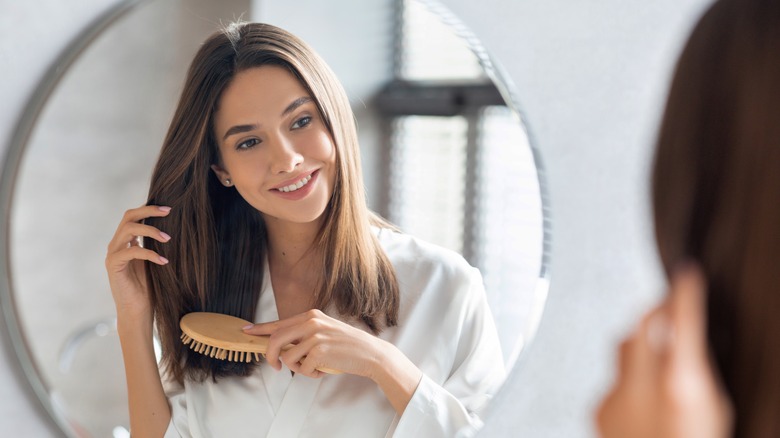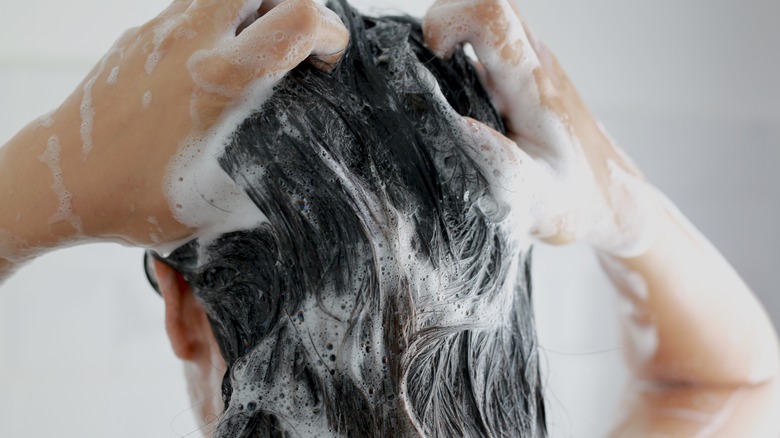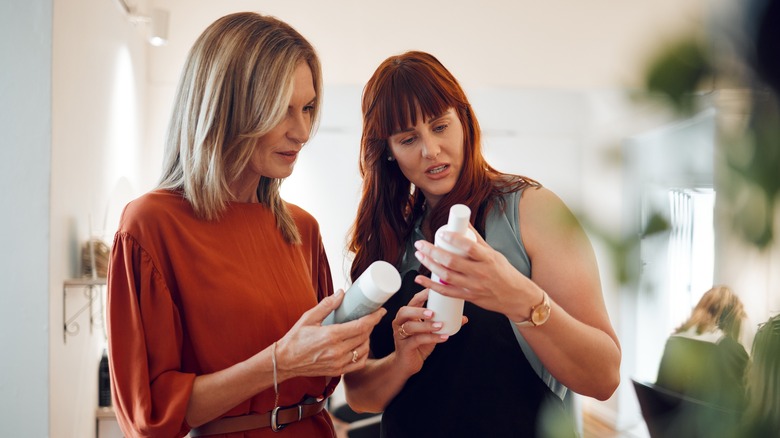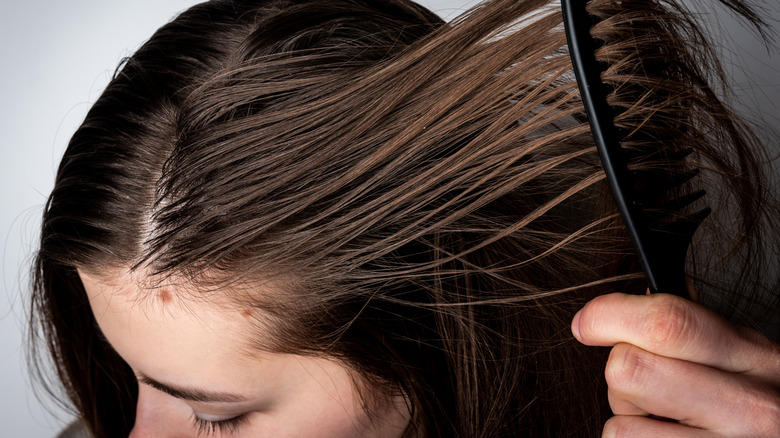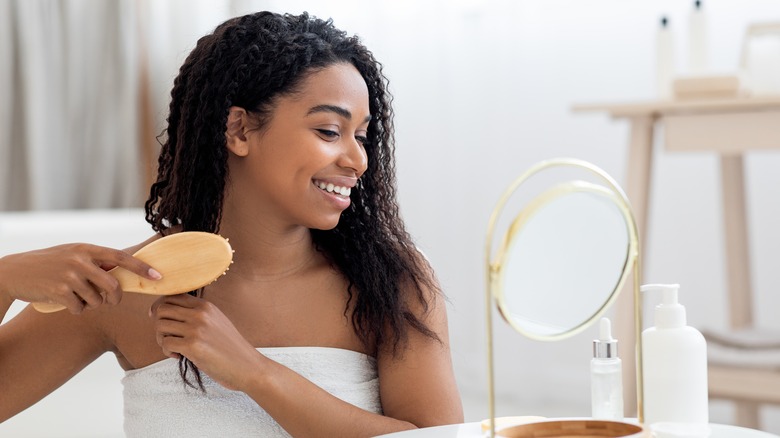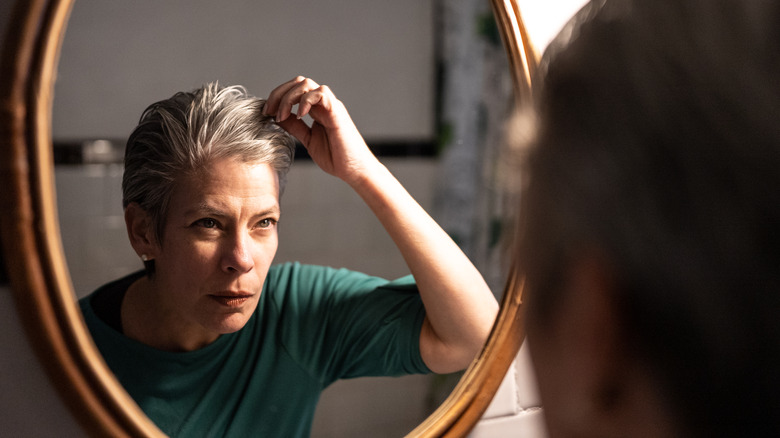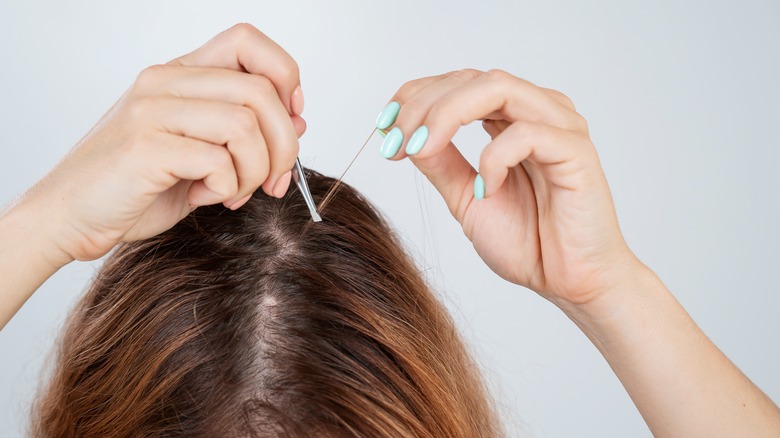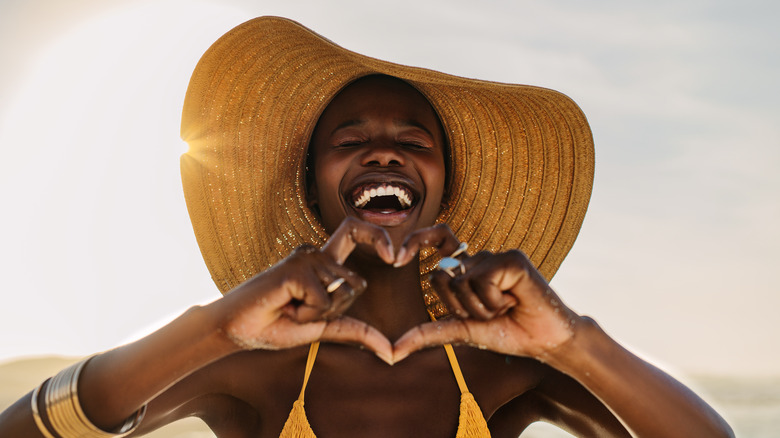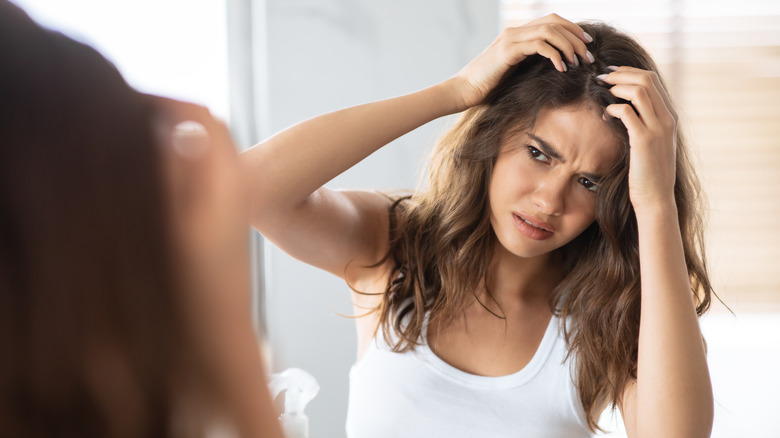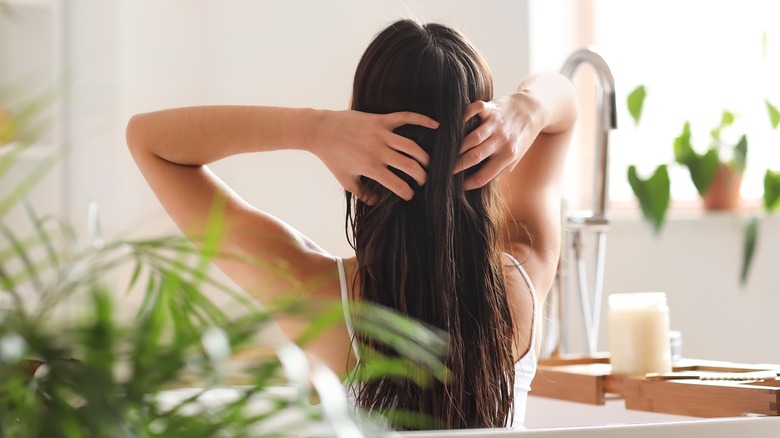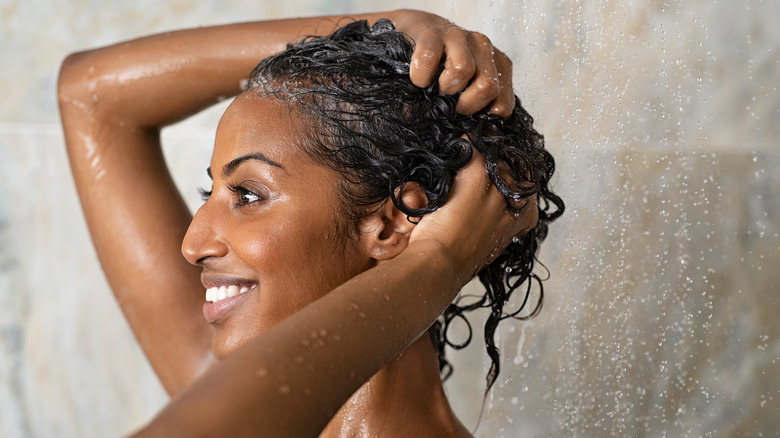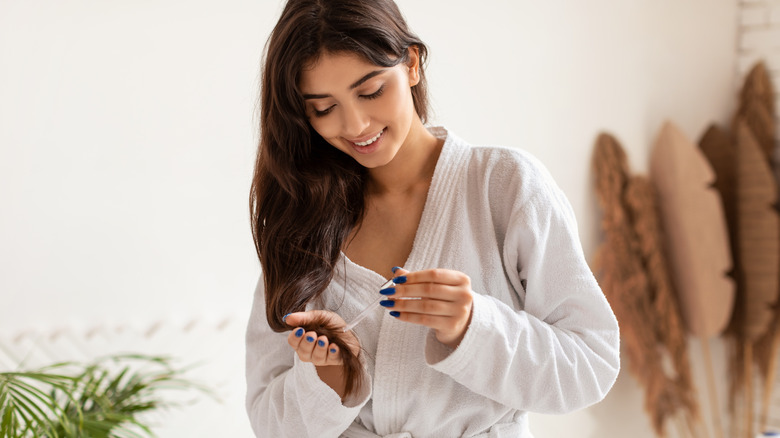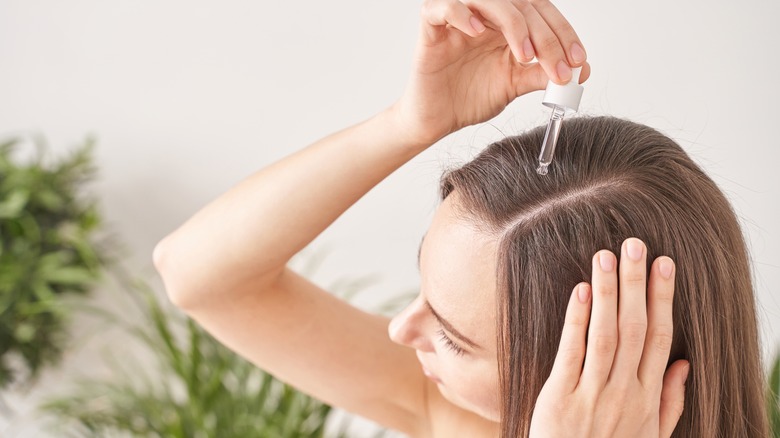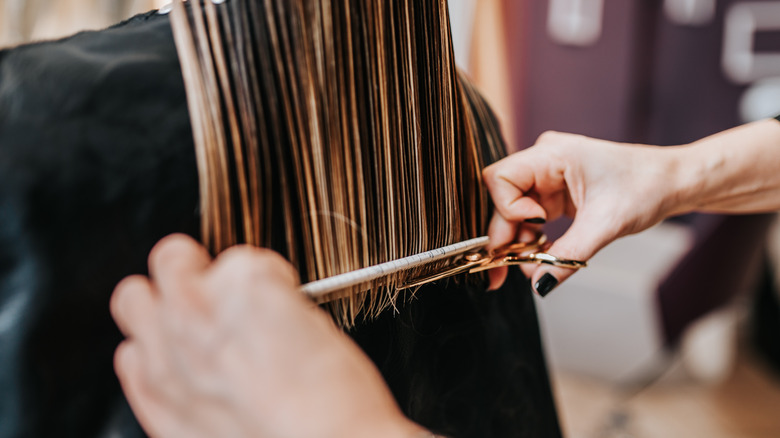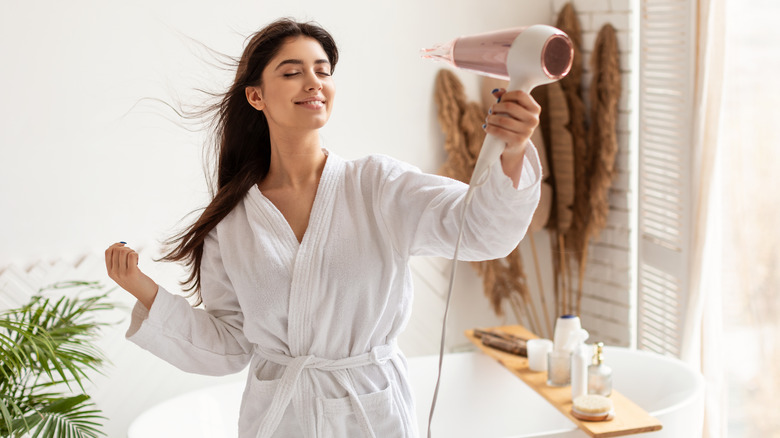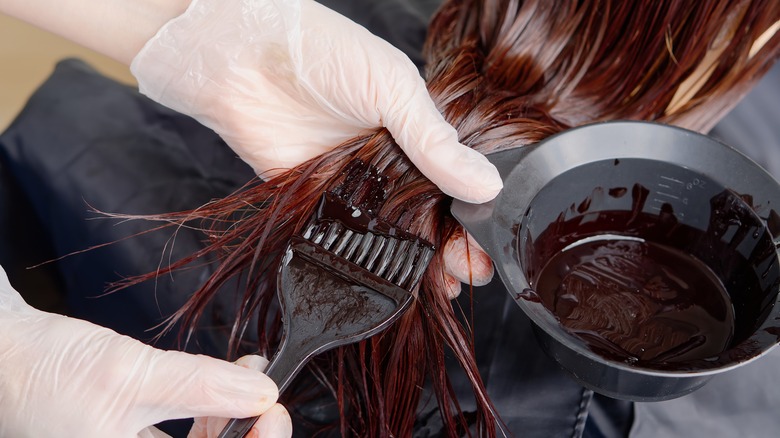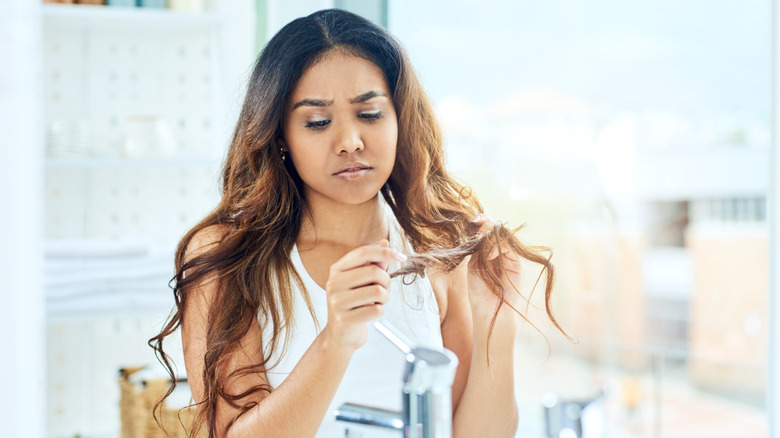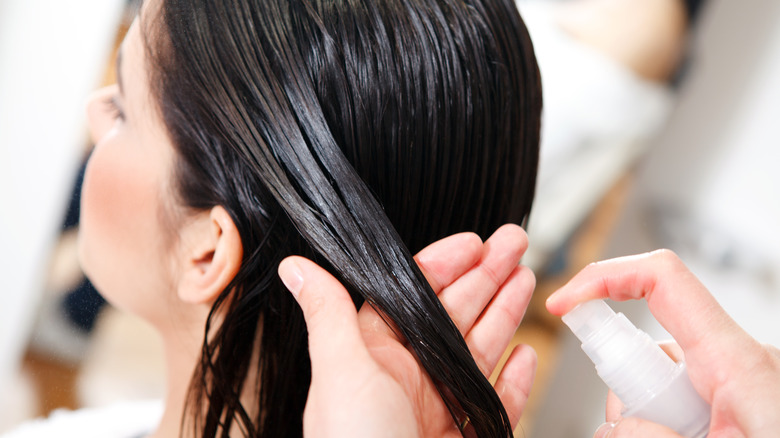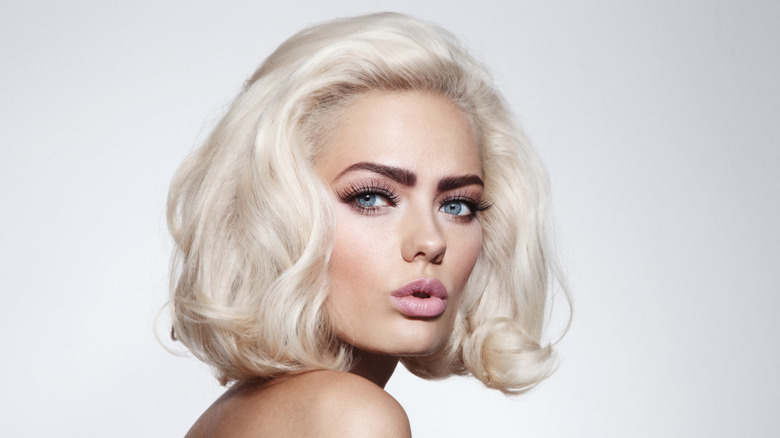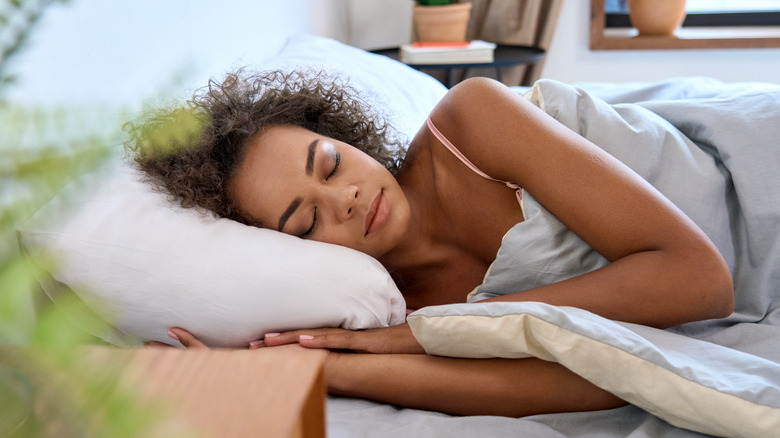20 Hair Myths You Need To Stop Believing
We may receive a commission on purchases made from links.
Having beautiful, healthy hair is a goal for most people, which is why hair myths about how to care for it properly continue to persist. "Hair matters in relation to our general sense of attractiveness; which is intrinsically connected to our confidence and self-esteem," Elaine Slater, The British Fashion Council's resident psychologist, tells Red Magazine. "Hair can give us the external appearance of being well-managed and in control ... It's also a fundamental means of expression of self; how we communicate our identity to the world."
In addition to hair's impact on our sense of self, proper hair care is simply good hygiene. Maintaining a healthy scalp will not only improve the look and feel of hair but is also vital for controlling and preventing a number of medical conditions. However, hair myths wavering classifications of what practices are "good" or "bad" causes plenty of confusion among people who just want to have nice, clean hair. No matter where you are in your hair journey or what your goals are, taking a look at the strange and common hair myths out there may be key to keeping your hair as healthy as possible.
Myth: You must lather, rinse, and repeat
The majority of shampoo products instruct users to "lather, rinse, and repeat." Some people believe this recommendation is just a manufacturing ploy to get people to use more products more quickly. However, these instructions are more likely a holdout from the early days of shampoo when people didn't wash their hair or bathe as often. At the time, encouraging multiple washes was simply a way to promote good hygiene.
However, not only do people today shower more often, but experts have also concluded that excessive shampooing can actually harm your hair. In addition to residue build-up, extra shampooing can cause a dry, flaky scalp, dull and frizzy hair, and split ends. "If you seem to be getting more split ends than usual, this could also be a sign of over-washing. Wet hair is so extra susceptible to damage and breakage, so the more you wash it, the more opportunity it has to break," celebrity stylist Tonya Le tells Insider.
Although repeated shampoos aren't necessary for most people, there are a couple of exceptions. Hairstylist Philip B tells HuffPost, "If you're not a frequent shampooer, two vigorous shampoos can help remove a week's worth of residue, pollution, and product build-up. Likewise, if you have a troubled scalp, shampooing twice is a good idea," adding that clarified and medicated shampoos can work well in conjunction with one another.
Myth: Hair gets accustomed to the same shampoo
If you've ever fallen for the frustrating idea that using the same shampoo over and over again is bad for your hair, take comfort in the fact that you're not alone. This common myth has led many people to believe that because their shampoo suddenly stops giving them the results that they want, somehow, their hair has grown accustomed to it. "A shampoo doesn't necessarily all of a sudden stop working," Kiku Chaudhuri tells Mane Addicts. "If your scalp and hair are not reacting properly to your shampoo after the first few washes, then most likely whatever is in your shampoo is not right for you. Also, another big factor of a shampoo's "magic" wearing off can be driven by what's externally happening in your life." Everything from the changing seasons to experimenting with new hair products can cause your scalp and hair needs to shift.
Variations in your constantly changing hair may also be a culprit. According to the plant-based hair and skincare brand Aveda, your hair is always growing and changing in texture or density. What hair products work for you after a fresh haircut may not be as effective when your hair has grown out or been freshly colored. This means that, although your favorite shampoo won't stop working, it may need to be supplemented with other products to help fill in the gaps. It's therefore wise to cycle between clarifying and gentle shampoos formulated for your specific hair type.
Myth: Shampooing more often reduces greasy hair
No one likes the look of greasy hair, no matter how important natural oil is for nourishing and moisturizing your tresses. Most people default to washing their hair more often in an effort to reduce the greasiness. In reality, overwashing your hair can force the scalp to overcompensate for the oil that is constantly being stripped away.
The good news is you can train an oily scalp to produce less oil. "You can train your scalp to be less greasy in the course of three to four days," celebrity hairstylist Sarah Potempa tells Who What Wear. "However, it will take some time for your body to fully adjust. Take some time to do research about the type of hair you have and establish a new routine that gives your body enough time to adjust to the change." Start by washing your hair every other day and slowly cut it down to once or twice a week, evaluating the condition of your hair as you go.
Training your hair to be less oily also requires being selective about the products you use. "If you do need to use a product with oil in it because your hair needs the moisture, avoid putting it on the scalp and use it on the lengths of your hair only," certified Trichologist Gretchen Friese recommends to Mane Addicts. "Consider also going silicone-free, as silicones can potentially trap other ingredients on the skin, including oil. Use sulfate-free shampoos, because they're great for an oily scalp."
Myth: You should brush your hair 100 strokes every night
Brushing your hair is necessary for smoothing and detangling purposes, but it's a complete myth that you need to run the brush through your hair 100 times a night to keep it healthy. Many women blame Marcia Brady and other famous television heroines for this weird haircare lore. However, according to the Bobby Pin Blog, this myth likely originated in the Victorian era as a way to promote good hygiene and remove lice nits. The myth persisted well into the 20th century, a time when women were not washing their hair as frequently as modern women do.
Regular hair brushing was also thought to boost hair growth by stimulating blood flow to the scalp, so the more you brushed, the more blood flow you'd experience. This, too, has been proven false. Although brushing your hair does help distribute the natural oils from your scalp to the ends of your hair, over-brushing can cause damage, breakage, and untamable frizz.
Myth: Stress causes your hair to turn permanently gray
Acute stress has long been thought to be a cause of prematurely gray hair, and recent evidence supports this theory. According to the National Institutes of Health, a 2020 research study found that mice subjected to mild, short-term pain and psychological stress resulted in graying hair. The study also found that noradrenaline, a neurotransmitter produced in the adrenal glands and which plays a role in the body's "fight-or-flight" response, was also a key player in turning healthy hair gray. This signal from the sympathetic nervous system reaches into each hair follicle and releases noradrenaline, altering the cells that produce pigment and leading to gray or white hairs as it grows.
However, is stress-related gray hair permanent? A 2021 study performed at Columbia University Vagelos College of Physicians and Surgeons says maybe not. An analysis of 14 people accumulated data that suggests graying hair from stress is reversible. "There was one individual who went on vacation, and five hairs on that person's head reverted back to dark during the vacation, synchronized in time," the study's senior author, Martin Picard, tells Science Daily. Of course, this reversal is largely dependent on the age and lifestyle of the person in question. An elderly individual with naturally gray hair won't be able to reverse their grays with simple relaxation. However, people who haven't approached the natural aging threshold for gray hair may be able to reverse their gray hairs by reducing their stress levels.
Plucking gray hairs will make more grow
Finding a random gray hair you weren't expecting can be alarming. The good news is that you can safely remove the hair without more popping up around it like some kind of silver Hydra. That's right: Pulling out a gray hair does not cause more to grow. "That's a complete myth because what you do to one follicle doesn't affect its neighbors," cosmetic scientist Randy Schueller tells Today. The hairs surrounding your single gray hair won't turn gray until their own pigment cells die.
However, that doesn't mean the gray hair you plucked is gone for good. "Plucking a gray hair will only get you a new gray hair in its place because there is only one hair that is able to grow per follicle," preventive medicine physician Dr. Shaskana Kraleti tells UAMS Health. "When you pluck a hair a new one will grow in its place and because the pigment cells are no longer producing pigment, this new hair will also be white."
Dr. Kraleti also notes that, while you can remove that errant gray hair, plucking can cause serious damage. "Plucking can traumatize the hair follicle, and repeated trauma to any follicle can cause infection, scar formation, or possibly lead to bald patches." If you are tempted to remove gray hair, carefully cut it off instead. Or, if you're feeling adventurous, use this as an opportunity to try out that gorgeous hair color you've been dreaming of for ages.
Myth: You can safely lighten your hair with sunlight
Sun-bleached hair is a beautiful reminder of warmth and summertime, of days at the beach and coconut-scented sunscreen. The bleached or golden effect also looks lovely. While many people believe that lightening your hair with sunlight and a squeeze of lemon juice is a more natural, cheaper, and less harmful method than bleaching at a salon, the truth is that UV rays can do a lot of damage to your hair and scalp.
In this instance, the sun's hair bleaching effectiveness does not equal safety. "Sun bleaching can cause your scalp to dry [up and] flake from the acid in the lemon [and] the UV rays from the sun," hair colorist Robert Bennett tells Shape. "The sun is not your friend, especially if you plan to be in it all day."
UV rays can also damage the keratin in your hair, leading to weak strands that are prone to breakage and frizz. Furthermore, since you have no control over how quickly the sun will bleach your hair, you can be out in the sun for hours unprotected. Prolonged exposure to UV light from the sun can damage the skin's cellular DNA, which puts you at a higher risk for skin cancer.
Myth: Wearing a hat will thin your hair
Wearing a hat is an excellent way to protect your scalp from the sun's harmful rays, especially when it has built-in UPF. Despite this, many people fear that wearing a hat consistently will cause their hair to thin. According to the Cleveland Clinic, this topic has not been studied extensively by scientists, which has led to some ambiguity among experts. While hats that are too tight may decrease blood flow to the hair follicles, this hair loss is likely temporary and can be remedied by leveling up your hat game to something a bit looser.
Any type of tight headwear can pull on your hair's roots and lead to minor but reversible hair loss, which no one wants. However, true hair loss is often the result of other factors such as stress, hormone levels, and medical conditions. While it's an unfortunate truth, there are only some of the many ways you can experience hair loss that are truly preventable.
Myth: Dandruff is the result of a dry scalp only
Due to its itchiness and flaky appearance, dandruff is often thought to be the result of a dry scalp. Contrary to popular belief, dandruff can be caused by a variety of conditions ranging from fungal infections to over or under-shampooing. It can also be caused by oily skin.
This condition, called seborrheic dermatitis, is a type of mild eczema that causes oily areas on the scalp to become inflamed, leading to flaky patches of skin. "[This] is an inflammatory scalp condition in which your body is overproducing skin cells in a particular area of the scalp and overproducing sebum (natural oils), which creates a compounded scalp flaking," certified trichologist William Guanitz tells Byrdie. This type of dandruff is often yellow and can extend past the scalp.
The most effective way to treat and control dandruff is to use appropriate dandruff shampoo. These shampoos contain active ingredients formulated to control symptoms. Many dandruff shampoos need to be lathered into the hair and allowed to sit for at least five minutes before rinsing. Depending on your ethnicity, hair needs, and scalp condition, treating dandruff may only occur one to two times per week.
Myth: Keratin treatments will save your hair
Keratin treatments (sometimes known as Brazilian blowouts, but not always) are beloved for their ability to turn normal hair into a soft, shiny, and glorious mane. They involve placing a solution through the hair to reseal damaged keratin, or the outer protective structure of the hair strand, reducing split ends and creating an altogether straighter, less frizzy look. Some stylists blow dry the solution and use a flat iron to seal it. The entire process takes up to four hours in a salon, with results lasting roughly six months with proper care.
Despite this, they aren't always a good idea. If done too often or improperly, keratin can actually lead to irreversible damage that only a dramatic haircut can solve. "Keratin is a strengthening ingredient," Adam Livermore tells Byrdie. "If you overbuild the structural integrity of a fiber as slender as a hair strand it becomes rigid and brittle, and it will snap even more easily than if you'd left it in a weakened state."
Some keratin treatments also use formaldehyde, a compound that contributes to a number of health issues, including an increased risk of cancer (via Healthline). So, while keratin treatments have their perks, they aren't miracle cures and shouldn't be used every day.
Myth: Rinsing with cold water makes your hair shiny
Haircare gospel states that rinsing with cold water is necessary for optimal scalp health and beautifully shiny hair. The idea is that cold water helps the cuticle or the outer layer of hair, lie flat, making hair appear smoother and shinier. Unfortunately, science has proven that this isn't the case. "In real life, whether you rinse with lukewarm water, mildly hot water, or cold water, the end result is going to be the same. Once hair is dry, the cuticle is going to be closed [anyway]," Leon-van Gorkom explains to All Things Hair. Cold water can also negatively affect the blood capillaries in your scalp, which are vital for carrying important nutrients to the hair follicles.
That being said, rinsing your hair with hot water isn't helpful either. "There is no evidence or scientific data to demonstrate that cold water improves the health of the hair," Dr. Gaby Longsworth, a certified hair practitioner, tells Vegamour. "That said, using hot water when washing your hair dissolves and rinses away the protective sebum, which is not good for the scalp or the hair. So, in that sense, cold water is better for your scalp and hair health than hot water." Ultimately, how you choose to wash your hair is your own choice. If you like rinsing with cold water, go for it! Just know that it probably won't make your hair shinier or more manageable in the long run.
Myth: Only dry hair needs to be hydrated and moisturized
People with wavy, curly, or coarsely-textured hair commonly deal with dry hair and brittle ends that require additional moisturizing. However, whether you have structurally dry hair or not, you will benefit from well-hydrated, moisturized hair. The more hydrated your hair is, the healthier and stronger it is. Doesn't that sound nice?
Healthy hair is hydrated when the inner layers can successfully absorb and retain water. The outer layer, or the cuticle, requires sealing in needed moisture with oils to keep the water from evaporating. Without both of these elements, hair can feel dry, dull, and lifeless.
We recommend doing a deep conditioning treatment or a hydrating mask at least once a week in addition to a semi-regular hair serum. You can also choose hydrating shampoos containing moisturizing ingredients like shea butter, coconut oil, and olive oil for a dose of daily hydration.
Myth: Hair and scalp oils will make your hair greasy
Hair oils are a great way to nourish and moisturize hair, but hair myths dictate that adding any kind of oil to your hair will make it greasy. While people with naturally oily scalps may need to apply hair oils to their ends only, all hair types can benefit from vitamin-rich hair oils.
Celebrity hairstylist Jennifer Korab tells Well + Good, "There is no rule that you must avoid hair oil if you have an oily scalp. In fact, there are many hair oils that will leave your scalp healthier and producing less natural sebum than before. Many hair oils also aim to add gloss to hair and the way they achieve this is with silicones that coat the hair."
Many hair experts swear by occasional hair oil applications to the scalp for stimulating blood flow and increasing circulation as well. "[Scalp massage also] helps to provide nutrients to the scalp, hydrate the hair, and prevents frizz," stylist Charlotte Mensah tells Coveteur.
Myth: Cutting your hair makes it grow faster
Every person who has ever wanted long hair has heard the old myth that cutting your hair will make it grow faster. But does that myth actually have any merit? Turns out, not really.
Regular hair trims are important for removing the dead ends that can make hair look damaged and unhealthy. "Trims are important because they cut split ends off so they don't climb up the hair and cause more split ends," stylist Mackenzie Day tells The Healthy.
However, because hair grows from the scalp, cutting off the dead stuff at the ends doesn't have any effect on how quickly it grows. According to Kiehl's, the average person's hair only grows 6 inches per year. Ultimately, no matter how badly you want it to grow faster, patience and proper hair care are the only ways to make hair grow, so you should stop cutting your hair at home in hopes that it will grow a specific way.
Myth: Air-drying is better than blow-drying
Hair experts and natural wellness gurus have cautioned against prolonged heat styling for years. Exposure to high heat from tools like curling wands and blow dryers can strip your locks of their natural oils. This can cause weaker, more brittle strands that are prone to breakage and split ends — and even "permanently burnt" strands can develop, according to Schwarzkopf Professional. In light of this information, many people ditched their heat styling tools altogether, opting for heatless curls and air-drying instead. In fact, one search of #HeatlessCurls on TikTok reveals over 5 billion views and counting.
As it turns out, blow-drying your hair isn't worse than air-drying. In fact, air-drying might actually be worse long-term. "Gently blow drying with the right hairdryer on the lowest heat and speed setting until it is 90 percent dry, is actually better than air-drying," celebrity hairstylist Cim Mahony tells Vogue Scandinavia. "When hair is wet it is stretched out, the result of water putting all these bonds under pressure ..." Mahony further explains. "Hair also loses its elasticity when wet, which means it will be more prone to breakage or being ripped out at the root."
Technique and temperature are important when you blow dry your hair to avoid heat damage, as is using the right hair products, towels, and detangling tools. But you don't need to be afraid your blow dryer will damage your hair every single time you use it.
Myth: Dyes takes better on dirty hair
Dying your hair is a fun and creative way to express yourself, whether you're brightening your natural look for summer or experimenting with every color on the color wheel. If you've never dyed your hair before, you might fall victim to the idea that the dye will set better if you go to the salon with dirty hair — but this is far from the truth.
It is often believed that the dirt and oils on the strands and scalp will act as a barrier to protect against chemicals. This may be true in certain situations, but most of the time, the chemicals likely will just "power through dirt and product residue to still color the hair," Naturcolor explains.
What's more, the buildup of products on your hair could be doing your dye job a disservice. "Product and metal and mineral buildup could interfere with the process and cause a chemical reaction," celebrity hairstylist Yusef tells Bustle. "This can end up causing uneven color and lift." The only time a hairstylist might recommend you come in with dirty hair is if you want to lighten your entire head, from root to tip. In this instance, the natural oils in your hair may be helpful in protecting your scalp from irritation from the lightener.
Myth: You can repair your split ends
It is easy to fall for shampoo and conditioner brands that claim their products can repair your split ends. After all, no one likes the look or feel of fraying hair. But the unfortunate truth is that once a hair is damaged, there isn't anything you can do to glue it back together. "The key to split-end management is to prevent them in the first place and get regular trims to snip them off," Ashley Feinberg, founder and CEO of Kavella Hair Care, tells Reader's Digest.
But how exactly do you prevent split ends? Gentleness is key. You don't want to aggressively shampoo, condition, or detangle your hair with a comb or brush, especially when wet. You should also avoid "rubbing your hair dry with a towel," which can result in hair damage and breakage (via Healthline).
Using low-heat styling tools and sleeping on a silk pillowcase to reduce friction while sleeping can also prevent unwanted breakage. You may never be able to prevent at least a few split ends from showing up, but with these tactics, you can begin to reduce their presence on your head.
Myth: Hair masks do the same thing as conditioner
Some people may believe that they can swap out their regular conditioner for a semi-regular hair mask and achieve the same results. While hair masks and conditioners have roughly similar end goals — to hydrate and nourish your hair — hair masks shouldn't replace regular conditioning, as they ultimately serve different purposes.
"A conditioner tends to be lighter in consistency, replenishes moisture, and is recommended for daily use," Jonathan Colombini, L'Oréal Paris creative director of style and color, explains to Real Simple. This hair product should only be left in the hair for a few minutes before being rinsed out.
Hair masks, on the other hand, are hair treatments made up of nourishing ingredients that penetrate the hair strand and work to condition it from the inside out. "A mask is more of a thicker fiber that restores softness and shine and is advised to use one to two times a week rather than daily," Colombini explains.
Myth: Your eyebrows should match your hair
There has never been a written rule that suggests your eyebrows must match your hair color, but current trends have made that soft rule practically nonexistent. "The trend right now is to have darker eyebrows than your actual hair color," celebrity colorist Kim Vo tells Today. "But they shouldn't be more than two levels darker than (your current color)." This is particularly good news for those who like to dye their hair frequently and don't enjoy the hassle of dying their eyebrows to match.
While you should feel comfortable expressing yourself through any number of colors and shades, if you want to keep your eyebrows looking complimentary, you might want to take care when choosing a shade. "Your hair on your face and around your face should frame and enhance your natural beauty," Christine Thompson, co-owner and color director at Spoke & Weal, tells InStyle. "Getting the tones and level right are essential to translating your look, whether it's soft or strong."
This means keeping your eyebrow shade within a couple of shades of the color on top of your head. Your hairstylist should also be able to assist in finding the correct eyebrow color for you if you need additional guidance.
Myth: Sleeping with your hair down makes it grow faster
You may already know that sleeping with the wrong pillowcase can cause friction that will wreak havoc on your fragile hair, particularly if you have fine hair prone to breakage or tangling. However, some people may worry that protective sleep hairstyles that reduce friction, such as braids or loose buns, can prevent their hair from being able to grow quickly.
As it turns out, it is a total myth that sleeping with your hair down will make it grow faster. In fact, for some, sleeping with your hair down may prove to be beneficial for overall hair health.
"While there is no evidence to show that sleeping with your hair down will make it grow faster, the method is often recommended if you are experiencing thinning or hair loss to ensure that you aren't causing additional breakage, damage, or tension at the root, which will ultimately result in added thinning/loss," dermatologist Doris Day tells Today. If you do prefer to sleep with your hair down, using a silk or satin pillowcase is recommended to keep your strands looking shiny, smooth, and tangle-free.
